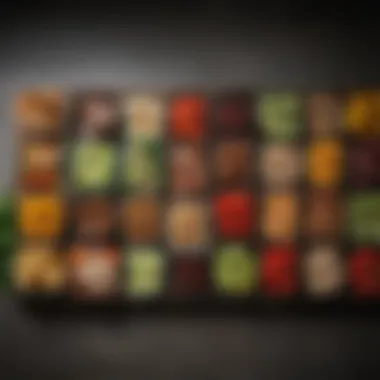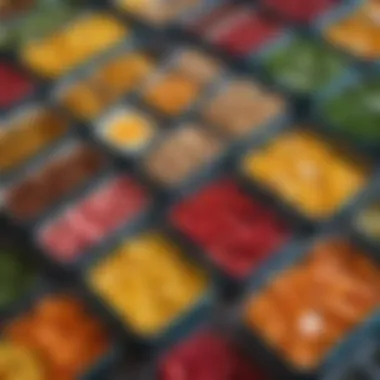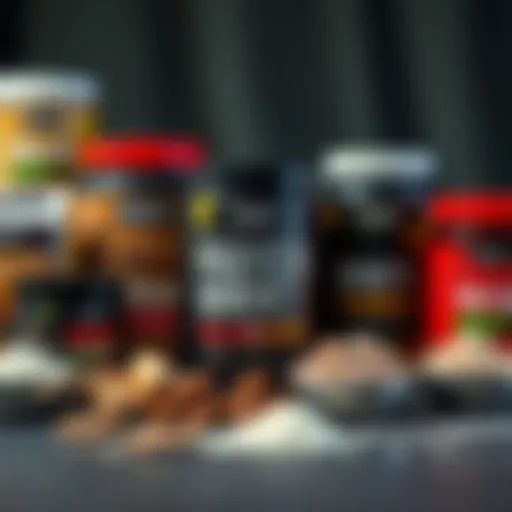Meal Prep Board: A Guide to Efficient Cooking


Intro
In the realm of culinary arts, efficiency and organization can transform cooking from a chore into an enjoyable experience. Meal prep boards serve as pivotal tools in this transition. This guide will delve into the significance of these boards, helping cooks streamline their kitchen processes. An effective meal prep board not only facilitates food organization but also promotes healthier eating habits through efficient preparation and storage techniques.
The importance of meal prep boards cannot be overstated. By keeping ingredients and tools at hand, they minimize time spent searching for items. This guide aims to illuminate how meal prep boards can enhance your cooking efficiency while providing practical tips tailored for various skill levels.
Recipe Overview
Recipe Name and Description
Cooking with intention is as significant as the ingredients used. A well-planned cooking session can help maximize the potential of a meal prep board. For example, consider a versatile recipe, such as a Mediterranean Chickpea Salad. This dish amalgamates fresh vegetables and protein-packed chickpeas, offering a nutritious meal option ideal for meal prep.
Cuisine Type
The Mediterranean diet is lauded for its health benefits. This cuisine emphasizes whole foods, healthy fats, and a variety of vegetables. The use of a meal prep board ensures that all ingredients are prepped efficiently, making it easier to create multiple servings for the week ahead.
Ingredients List
Detailed Ingredient Breakdown
- Chickpeas: The primary protein source, rich in fiber.
- Cucumber: Adds freshness and crunch to the salad.
- Bell Peppers: Offers color and vitamins.
- Red Onion: Introduces a mild sharpness.
- Feta Cheese: Enhances flavor; optional for a vegan version.
- Olive Oil: A key healthy fat source for dressing.
- Lemon Juice: Adds acidity and brightness.
- Herbs (Parsley, Oregano): For added aroma and depth.
Substitutions for Dietary Needs
- Chickpeas: Substitute with black beans for a different flavor.
- Feta Cheese: Omit for vegan diets, or use tofu for a similar texture.
- Olive Oil: For low-fat options, consider using low-sodium vegetable broth.
Efficient cooking practices revolve around preparation and organization. By employing a meal prep board, not only does one save time, but they also cultivate healthier eating habits, paving the way for delightful culinary experiences.
Understanding Meal Prep Boards
The functionality and advantages of meal prep boards are essential to grasp for anyone interested in efficient cooking practices. Meal prep boards serve as fundamental tools that significantly aid in organizing various cooking tasks, allowing cooks to streamline their workflow and enhance culinary efficiency. By using these boards, individuals can set up their cooking stations with precision, making the entire cooking experience more pleasant and less chaotic.
Definition and Purpose
Meal prep boards are specifically designed surface areas tailored for the preparation of food. Their primary purpose is to offer a clean and organized environment for chopping, mixing, and assembling ingredients. The board provides a designated space for both raw materials and final meal presentations, minimizing clutter. This organization not only saves time but also improves the overall cooking process.
Key benefits of using meal prep boards include:
- Hygiene and Safety: Meal prep boards can be a safe and sanitary choice, reducing cross-contamination by isolating different food types.
- Efficient Workflow: By pre-arranging ingredients, cooks can work through their tasks with greater speed and fewer interruptions.
- Ease of Cleaning: Many boards are designed to be easy to wipe down after use, ensuring a quick clean-up, which is crucial for maintaining a tidy kitchen environment.
The Evolution of Meal Prep Boards
The concept of meal prep boards has changed significantly over time. Historically, simple wooden cutting boards were the norm in kitchens worldwide. As culinary practices evolved, so did the design and materials used for these boards. Today, meal prep boards come in various types, each offering unique advantages.
The advent of new materials like bamboo, plastic, and composite has allowed for greater flexibility and functionality. Modern boards may also include features such as built-in measuring guides, compartments for organizing ingredients, or even sections designed specifically for particular tasks. As more people embrace meal preparation as a lifestyle, the evolution of these boards reflects changes in both cooking techniques and health-conscious behaviors.
The growth of meal prep culture has led to a surge in interest and innovation, making these boards an indispensable part of many kitchens today. The versatility and multifunctionality of meal prep boards now offer culinary enthusiasts the tools they need to enhance their cooking experiences.
Types of Meal Prep Boards
Understanding the types of meal prep boards is crucial for any culinary practice. Each type offers distinct advantages and challenges. The material used, the size, and the maintenance requirements all influence cooking efficiency and food safety. Choosing the right board can enhance your overall cooking experience and ensure you meet your culinary goals. Different materials also suit various cooking styles and preferences, which can be beneficial for home cooks aiming for both functionality and aesthetics.
Wooden Boards
Wooden boards are often favored for their natural beauty and durability. They are gentle on knives, which helps maintain sharpness. One significant advantage is that wooden boards tend to have natural antibacterial properties. This characteristic limits bacterial growth, making them a safer choice for food preparation. Popular wood types include maple, walnut, and cherry, each bringing its unique grain and color.
However, wooden boards require special care. They should be hand-washed with mild soap and should not be soaked in water. Regular oiling helps to maintain their condition, preventing cracks and warping.
Plastic Boards
Plastic boards are widely recognized for their affordability and ease of maintenance. They are often dishwasher safe, making them convenient for busy kitchens. Plastic boards come in various colors, which aids in preventing cross-contamination by designating specific boards for different food types. This reduces the risk of foodborne illnesses.
Despite their advantages, plastic boards can develop deep scratches over time, which can harbor bacteria. Regularly replacing them when they show signs of wear is essential for maintaining hygiene.


Bamboo Boards
Bamboo boards are an eco-friendly alternative that has gained popularity in recent years. They are harder than most wood, which means they resist cuts and scratches effectively. Bamboo’s antimicrobial properties contribute to a cleaner preparation surface. Additionally, they are lightweight and often more affordable than traditional wooden boards.
Nonetheless, some bamboo boards may not withstand prolonged soaking. Therefore, washing them quickly and drying them immediately is recommended to prolong their life.
Glass Boards
Glass boards offer a sleek and modern aesthetic. They are non-porous, which means they do not absorb odors or stains. This quality makes them suitable for a range of food items, especially for those who prepare a variety of dishes. Cleaning is straightforward, as these boards can be sanitized easily.
However, glass boards can be quite heavy and may pose a risk to knives due to their hard surface, which can dull blades over time. They are better suited for tasks like slicing fruits or vegetables, rather than preparing meat.
Composite Boards
Composite boards combine various materials to create a durable and versatile option for meal prep. They often include a mix of wood fibers and plastic, which provides the benefits of both materials. Composite boards are resistant to scratches and dents, ensuring longevity and ease of care.
One drawback is that they may not possess the same antibacterial properties as solid wood. This means additional attention to cleaning is necessary to maintain safe cooking practices. Nonetheless, they stand out for their balance between functionality and aesthetic appeal, making them a valuable addition to the kitchen.
Key Features to Consider
When selecting a meal prep board, understanding its key features is essential to optimize both your cooking and food preparation experience. Various factors determine how well a meal prep board performs its function. Selecting the right one can lead to better meal organization, safety in food prep, and an enjoyable cooking process.
Material Durability
Durability is one of the most important aspects of a meal prep board. A good board should withstand repeated use without showing signs of wear. Wooden boards, while often favored for their aesthetic appeal, require regular maintenance to prevent warping or cracking. Plastic boards, on the other hand, offer resilience against cuts and stains, but might wear out faster over time. Considering how often you will use the board helps in understanding which material fits best. For those who meal prep frequently, a durable board made from composite materials can provide a long-lasting solution.
Size and Thickness
The dimensions of your meal prep board play a crucial role in how effective it is during cooking. A properly sized board allows ample space for food cutting and ingredient organization. A larger board can accommodate multiple ingredients, preventing cross-contamination. Thickness is also important; thicker boards tend to be sturdier and more stable when chopping dense foods. However, they may be more cumbersome to store. You should evaluate your kitchen space and storage capabilities to choose a board that is practical for your needs.
Surface Texture
Surface texture is often overlooked, but it can significantly impact your meal prep experience. A smooth surface may facilitate easier chopping and sliding of food, while a textured surface can provide better grip and control when cutting. Materials such as bamboo may offer a balanced texture, providing both a slight grip and smoothness. Consider the types of foods you will be preparing when choosing a board based on texture. For instance, if you work with a lot of raw meat, a surface that allows for easy clean-up minimizes the risk of bacterial contamination.
The right meal prep board not only enhances your cooking experience but also promotes safe kitchen practices and efficient food management.
How to Effectively Use a Meal Prep Board
Using a meal prep board effectively can transform your cooking experience. By organizing your ingredients and streamlining your cooking processes, you not only save time but also enhance the overall efficiency in the kitchen. This section delves into how to maximize the benefits of your meal prep board, providing insights into two main aspects: organizing ingredients and streamlining cooking processes.
Organizing Ingredients
Proper organization of ingredients on your meal prep board is key for successful meal prep. When you combine different items efficiently, you create a comfortable and accessible workspace. Here are some practical tips for doing so:
- Group Similar Items: Place items like vegetables, proteins, and grains together. Keeping similar items close simplifies the cooking process.
- Cut and Chop Ahead: Prepping your vegetables or proteins beforehand saves significant time during cooking. Chopped items can fit neatly on the board, ready for use.
- Use Containers: Small containers can help separate different ingredients, preventing cross-contamination and making cleanup easier. Clear containers allow for easy visibility of what is prepped.
"A well-organized board can significantly cut down cooking time and improve your culinary experience."
Thoughtful organization can reduce stress when in a fast-paced meal-prepping session. Moreover, it ensures that you have everything you need within reach, which also contributes to better ingredient handling and sanitation.
Streamlining Cooking Processes
Streamlining your cooking processes using a meal prep board offers multiple benefits. It allows for a more focused approach to cooking, decreasing the likelihood of mistakes. To help facilitate this, consider the following:
- Sequential Arrangement: Arrange your ingredients in the order they will be used. This minimizes the time spent searching for items during cooking.
- Designate Spaces: Use parts of your meal prep board for specific tasks. For example, keep chopping tools on one side and prepped ingredients on the other.
- Batch Cooking: Prepping multiple meals at once can save energy and time. Use the meal prep board to keep all the components of each meal organized and concise.
Effective use of a meal prep board not only enhances workflow in the kitchen but also improves the quality of the meals you cook. By investing time into organizing your workspace, you lay the groundwork for a smoother and more enjoyable cooking experience.
Recipes Ideal for Meal Prep
The importance of selecting the right recipes for meal prep cannot be understated. Recipes that lend themselves well to preparation in advance can vastly improve efficiency and streamline daily cooking tasks. When meals are prepped ahead of time, individuals can enjoy home-cooked food without the stress that often accompanies daily cooking. In addition to saving time, ideal meal prep recipes also help with portion control, dietary considerations, and reducing food waste.
When considering recipes for meal prep, it is essential to focus on versatility, flavor retention, and storage compatibility. The key is to select meals that can be easily customized, frozen, and reheated without compromising quality. This approach will ensure that cooking becomes less of a chore and more of a rewarding experience.


Here, we explore two important concepts: batch cooking and healthy choice recipes, further elucidating how they contribute to a successful meal prep routine.
Batch Cooking Concepts
Batch cooking involves preparing large quantities of food at once, allowing for quick reheating and serving throughout the week. This technique can significantly reduce cooking time on busy days, enabling individuals to enjoy nutritious meals with minimal effort. Typical meals suited for batch cooking include stews, soups, and grain-based dishes.
Key benefits of batch cooking include:
- Time Efficiency: Preparing multiple meals at once saves time during the week.
- Cost-effectiveness: Buying in bulk can reduce grocery expenses.
- Less Food Waste: By pre-portioning meals, less food is thrown away.
Pro tips for successful batch cooking:
- Plan your meals for the week by selecting compatible recipes that share similar ingredients.
- Cook and portion meals into containers right after preparation to make reheating easy.
- Label containers clearly with dates and contents to ensure freshness and easy access.
Healthy Choice Recipes
Incorporating healthy choices into meal prep recipes is essential for maintaining a balanced diet. Healthy recipes are those that focus on whole, nutrient-dense ingredients while maximizing flavor. This approach not only promotes better health but also contributes to sustainable eating habits.
Some healthy meal prep options include:
- Grilled Chicken with Quinoa and Vegetables: This meal is packed with protein and fiber and is easily reheatable.
- Vegetable Stir-fry with Brown Rice: A colorful dish loaded with vitamins and antioxidants, great for freezing.
- Chickpea Salad: Full of fiber and protein, it can be made in advance and stored for days.
When selecting recipes, consider ingredients that have a longer shelf life or freeze well. This not only makes meal prep more manageable but also broadens the variety of meals available throughout the week. Adjusting recipes to adhere to dietary needs ensures that meal prep can be enjoyable and inclusive for everyone.
"Meal prep is not just about cooking in advance; it's about setting the stage for a healthier lifestyle, one meal at a time."
Storage Solutions for Prepped Meals
Efficient storage solutions are essential for maintaining the quality and safety of prepped meals. Organizing meals correctly not only extends their shelf life but also enhances the overall cooking experience. Proper storage techniques contribute to food safety, minimize waste, and ensure that meals remain fresh and enjoyable. Selecting the right containers and labeling them effectively plays a significant role in this process.
Choosing Containers
When it comes to selecting containers for meal prep, there are several factors to consider. Material is paramount as it affects durability and safety. Common materials include:
- Glass: Safe for microwaves and ovens. Glass containers are non-reactive and do not retain odors. They are more durable but can be heavy.
- Plastic: Lightweight and often less expensive. Ensure that the plastic is BPA-free to avoid harmful chemicals leaching into food. Some plastics may not be suitable for high-heat usage.
- Stainless Steel: Excellent for keeping food warm or cold. They are durable and do not retain flavors or odors, but they are not microwave-safe.
Size is another crucial factor. Large containers work well for bulk meals, while smaller ones are ideal for individual portions. Airtight lids are essential to prevent spoilage and keep meals fresh.
Labeling Methods
Labeling is a straightforward yet effective strategy for ensuring organization in the kitchen. Proper labels allow you to identify meals quickly and efficiently. Here are some practical methods:
- Expiration Dates: Always include the date the meal was prepped. This helps track freshness and ensures you consume meals before they spoil.
- Contents: Listing the meal's name or main ingredients provides a clear overview of what is stored, making it easier to plan your meals throughout the week.
- Color Coding: Using different colored labels for different types of meals can enhance organization. For instance, use blue for vegetarian options, red for meats, and green for salads.
Effective labeling can save time and reduce food waste by ensuring food is consumed while it is still fresh.
Implemeting these storage solutions significantly enhances the efficiency of meal prep. By carefully selecting containers and employing effective labeling methods, not only do home cooks enjoy the benefits of well-organized meals, but they also contribute to improved eating habits and reduced wastage.
Best Practices for Meal Prep
When it comes to meal prep, adopting best practices can significantly influence how efficiently you work in the kitchen. This section emphasizes essential strategies that help streamline the meal preparation process. By implementing these practices, not only is the cooking experience simplified, but it can also promoting healthier eating habits.
Cleaning and Maintenance
Maintaining a clean preparation area is vital for food safety and ensures a pleasant cooking environment. Begin by keeping your meal prep board clean before and after every use. It's recommended to wash the board with hot, soapy water, following with a thorough rinse to remove any bacteria or food particles. For wooden and bamboo boards, it’s crucial to avoid soaking them in water as this can warp the material. Instead, opt for a damp cloth to wipe down the surface. Regular oiling of wooden boards, using mineral oil specifically designed for food safety, also protects against deep cuts and helps maintain texture.
Additionally, sanitize the board by using a mixture of water and vinegar, which can reduce bacteria without harsh chemicals. Make it a habit to clean knives and other tools that come into contact with raw foods. This level of diligence not only maintains the integrity of your ingredients but also elevates the entire cooking process by reducing the risk of cross-contamination.
Safety Considerations
Safety in the kitchen should never be overlooked. When using meal prep boards, it is important to understand the implications of food safety. First, always use separate boards for different food types—one for raw meats, another for vegetables, and a third for cooked dishes. This practice minimizes the risk of foodborne illness.
It is also wise to have a consistent cleaning schedule, particularly in between different stages of meal prep. Ensure your kitchen is organized, with all utensils, boards, and ingredients clearly designated for specific tasks.


Importance of using a thermometer: Check the internal temperatures when cooking certain meats, as this assures that they are cooked thoroughly, reducing risk. When marinating food, avoid using the same containers that held raw meats.
In summary, establishing best practices for meal prep is not just about efficiency. It ensures a safe, clean, and enjoyable cooking experience. By staying organized and prioritizing cleaning and safety, you enhance both the process and quality of your meals.
Incorporating Meal Prep into Daily Life
Integrating meal prep into daily routines can lead to a smoother, more organized cooking experience. A proactive approach to meal preparation simplifies the process of cooking in what can often feel like a hectic schedule. It provides structure, saving time and effort throughout the week. With the right strategies, meal prep enhances not only convenience but also fosters healthier eating habits by making nutritious meals readily available.
Scheduling Meal Prep Days
Scheduling specific days for meal prep is essential for success. Dedicating time blocks during the week can ensure that meal prep does not become an afterthought surrounded by busyness. Typically, setting aside time on weekends is popular since it allows for planning meals for the week ahead. Here are some effective pointers to consider:
- Choose a consistent day: A predictable schedule fits better in people's routines.
- Time management: Set aside two to four hours to maximize prep time without feeling rushed.
- Be realistic: Select a day when energy levels are usually higher to facilitate a more enjoyable prep experience.
Creating a checklist can enhance efficiency. This list may include meals to prep, grocery items needed, and any special equipment required. With a well-structured plan, the process becomes straightforward.
Adjusting to Dietary Needs
When incorporating meal prep, one must consider individual dietary requirements. Each person has unique nutritional needs based on health goals, cultural backgrounds, and personal choices. Meal prep can effectively cater to these needs with custom meals that satisfy specific dietary restrictions. It is imperative to:
- Understand dietary limitations: Whether one follows a vegetarian, vegan, gluten-free, or other specific diets, knowing what to include is essential.
- Research recipes: Numerous resources exist for tailored meal prep ideas. Utilizing these saves time and caters to specific tastes.
- Portion control: Preparing meals in suitable portions can prevent overeating while allowing flexibility in dietary management.
"Personalized meal prep can transform eating habits and ensure nutritional goals are met daily."
Adapting meal prep to fit these requirements not only supports better health choices but also fosters satisfaction with meals. Individuals are more likely to stick with their nutritional goals when meals are both delicious and aligned with their preferences.
Exploring Meal Prep Trends
Understanding trends in meal prep is crucial for any culinary enthusiast aiming to optimize their cooking practices. Trends often reflect changing preferences, emerging technologies, and evolving health considerations. Exploring these trends is not merely about keeping up with popular habits; it is about embracing practices that enhance efficiency in the kitchen and contribute to a healthier lifestyle.
Sustainable Practices
Sustainability has become a focal point in various industries, including cooking. In meal prep, this translates to choosing ingredients and tools that minimize environmental impact. Using locally sourced produce can drastically reduce carbon emissions associated with transportation. Additionally, opting for meal prep boards made from recycled or sustainably harvested materials is an excellent way to support eco-friendly practices.
Here are some key sustainable practices to incorporate:
- Selecting Organic Ingredients: Organic produce often comes from farms that employ sustainable methods, which prioritize soil health and biodiversity.
- Composting: Scraps from meal prep can be composted, thus reducing kitchen waste and benefiting garden soil.
- Reusable Containers: Instead of single-use plastics, use glass or stainless-steel containers for storage. They are durable and better for the environment.
"Embracing sustainable practices in meal prep not only helps the planet but often leads to fresher and tastier ingredients."
Incorporating sustainable methods into meal prep encourages awareness of food waste and inspires others in the culinary community to follow suit. This shift creates a more mindful approach to cooking.
Innovations in Meal Prep
Technology and innovation have played significant roles in shaping the meal prep landscape. Various kitchen gadgets and techniques have emerged, making meal preparation more efficient and accessible. From smart kitchen appliances to innovative storage solutions, these advancements provide both convenience and improved quality in meal prep.
Some noteworthy innovations include:
- Smart Meal Prep Apps: Applications like Mealime or Yummly can generate meal plans based on dietary restrictions, automatically create shopping lists, and even suggest recipes.
- High-Tech Appliances: Instant Pots and air fryers have revolutionized cooking, allowing for faster preparation times and versatile cooking methods.
- Meal Prep Kits: Services like HelloFresh or Blue Apron offer curated meal prep kits that simplify the process, making it easier for busy individuals to cook healthy meals at home.
These innovations not only save time but also help demystify cooking for those who may feel intimidated by the process. They appeal to a wide range of skill levels, highlighting that meal prep can be both enjoyable and practical.
In summary, exploring these trends provides insights into improving cooking practices. Adopting sustainable methods and leveraging innovative technologies contribute significantly to creating an efficient and eco-friendly meal prep environment.
End
In the realm of efficient cooking practices, meal prep boards stand out as essential tools for enhancing culinary workflows. Their importance cannot be understated. By providing a dedicated space for ingredients, these boards facilitate organization and promote an efficient cooking experience. A clear, organized surface allows cooks to focus on the task at hand, leading to quicker meal preparation and reduced kitchen clutter.
Summary of Key Points
- Functionality: Meal prep boards help streamline the cooking process, allowing for better organization of ingredients.
- Types and Materials: Different types of boards—wooden, plastic, bamboo, glass, and composite—each come with unique advantages that cater to various culinary needs.
- Best Practices: Proper maintenance and safety considerations are crucial to keep these boards in optimal condition.
- Trends and Innovations: Sustainable practices and new innovations continue to evolve in the meal prep space, indicating a growing interest in efficient cooking solutions.
A meal prep board serves as a cornerstone in the kitchen, transforming the way individuals approach meal preparation. It resonates with both novice cooks and seasoned chefs, ultimately enhancing the cooking experience and promoting healthier eating habits over time.
Encouragement for Continued Exploration
As the culinary landscape continues to evolve, exploring different meal prep techniques and innovations can lead to discovering new methods to enhance efficiency in your cooking. Engaging in meal prep is not just a trend; it is an approach that can make a significant difference in your everyday cooking routine.
Food lovers are encouraged to experiment with various types of meal prep boards and storage solutions. Whether you aim to optimize your kitchen space or seek healthier cooking practices, knowledge is key. Follow developments in this field, share experiences with other enthusiasts through platforms like Reddit and Facebook, and learn about further innovations.
By embracing the potential of meal prep boards, you unlock a more enjoyable, systematic cooking practice. Delve into diverse resources, apply what you learn, and keep refining your culinary skills. Your kitchen is a canvas—let the meal prep board be your palette.















